Cracker Barrel Old Country Store Bundle
How Well Do You Know Cracker Barrel's Story?
Step back in time and discover the captivating Cracker Barrel Old Country Store SWOT Analysis! From its humble beginnings to its current status as a cultural icon, the Cracker Barrel company story is a fascinating journey. Explore the unique blend of dining and retail that has made Cracker Barrel a beloved destination for generations. Uncover the secrets behind its enduring appeal and strategic evolution.
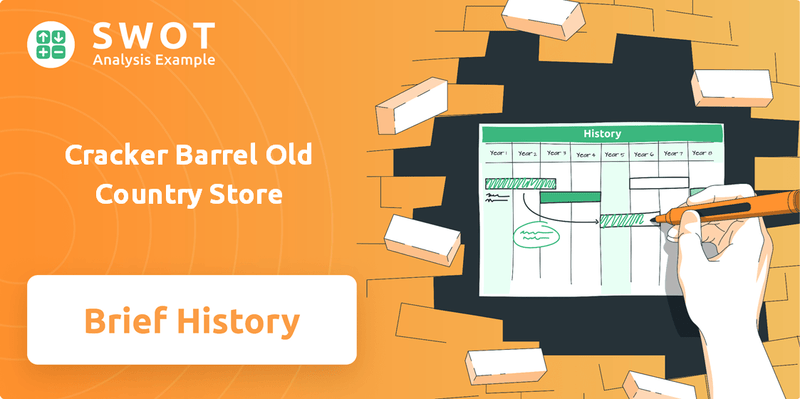
The Cracker Barrel history is a testament to innovative thinking and a keen understanding of the American consumer. From its Cracker Barrel origins in Lebanon, Tennessee, to its expansive presence across the United States, the company's timeline is filled with strategic decisions. Learn about the founder's vision and how Cracker Barrel restaurants have become a staple in the casual dining landscape, shaping American culture along the way. Delve into the Cracker Barrel's unique store concept history and its impact on the market.
What is the Cracker Barrel Old Country Store Founding Story?
The Cracker Barrel Old Country Store has a rich history, beginning with its establishment on September 19, 1969. The company's founder, Dan Evins, played a pivotal role in shaping the business.
Evins, leveraging his experience from his family's gasoline business, saw an opportunity to create a unique roadside stop. His vision combined a gas station, restaurant, and gift shop, offering travelers a blend of convenience and a welcoming atmosphere. This innovative approach set the stage for what would become a well-known brand.
The first Cracker Barrel location opened in Lebanon, Tennessee, strategically placed near Interstate 40. This placement was crucial, reflecting Evins' understanding of the needs of interstate travelers. The early years of Cracker Barrel focused on providing homestyle Southern cooking in a rustic setting, complemented by a retail store selling nostalgic goods.
Cracker Barrel's early success was due to its unique business model and strategic location.
- Cracker Barrel origins can be traced back to Dan Evins' vision to create a welcoming stop for travelers.
- The dual-concept approach, combining a restaurant and retail store, was innovative at the time.
- Initial funding came from Evins' family gasoline business, showing a bootstrapping approach.
- The name 'Cracker Barrel' was chosen to evoke the imagery of old country stores.
Cracker Barrel Old Country Store SWOT Analysis
- Complete SWOT Breakdown
- Fully Customizable
- Editable in Excel & Word
- Professional Formatting
- Investor-Ready Format
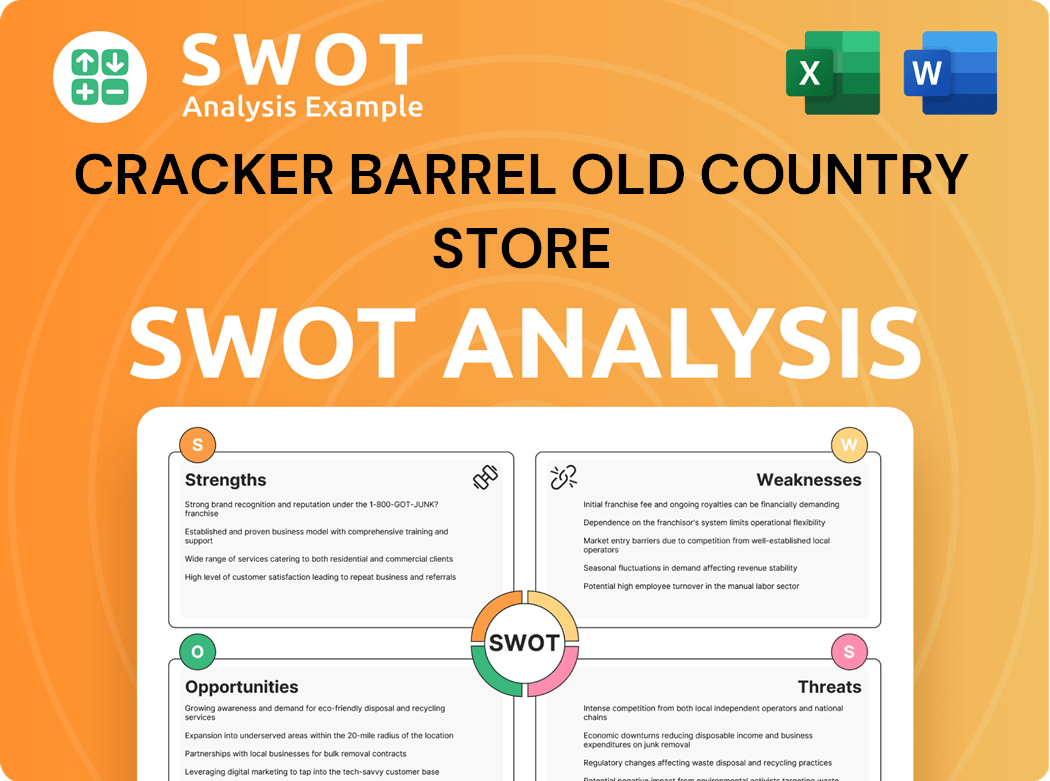
What Drove the Early Growth of Cracker Barrel Old Country Store?
The early growth of the Cracker Barrel Old Country Store company was marked by a strategic focus on interstate highways, attracting travelers. Following the success of its initial location, the company expanded its unique restaurant and retail concept across the Southeast. This expansion included diversifying its menu and retail offerings. By the end of the 1970s, Cracker Barrel had established a growing presence, solidifying its brand identity.
The company's initial team expansion focused on operational staff to maintain service and product quality. Regional offices were established to support the growing network of stores. The initial public offering (IPO) in 1981 was a significant milestone, providing capital for more aggressive expansion. This allowed the company to enter new geographical markets beyond the Southeast.
Consumers appreciated the consistent quality, value, and nostalgic atmosphere of Cracker Barrel restaurants. Despite the competitive casual dining and retail landscape, the company differentiated itself through its dual model and commitment to a distinct brand experience. Strategic decisions focused on maintaining operational efficiency while scaling the business, ensuring the charm of the original store was replicated across new locations. The Revenue Streams & Business Model of Cracker Barrel Old Country Store provides further insights into their operational strategies.
By the early 1990s, Cracker Barrel had become a recognizable brand with a national footprint, demonstrating sustained growth fueled by its successful expansion strategy. This expansion was supported by a strong business model and effective marketing. The company's growth trajectory was characterized by strategic decisions aimed at balancing expansion with maintaining its unique brand identity and operational efficiency.
As of fiscal year 2024, the company reported total revenue of approximately $3.4 billion. The company operates around 660 stores across the United States. The company's market capitalization is approximately $1.8 billion.
Cracker Barrel Old Country Store PESTLE Analysis
- Covers All 6 PESTLE Categories
- No Research Needed – Save Hours of Work
- Built by Experts, Trusted by Consultants
- Instant Download, Ready to Use
- 100% Editable, Fully Customizable
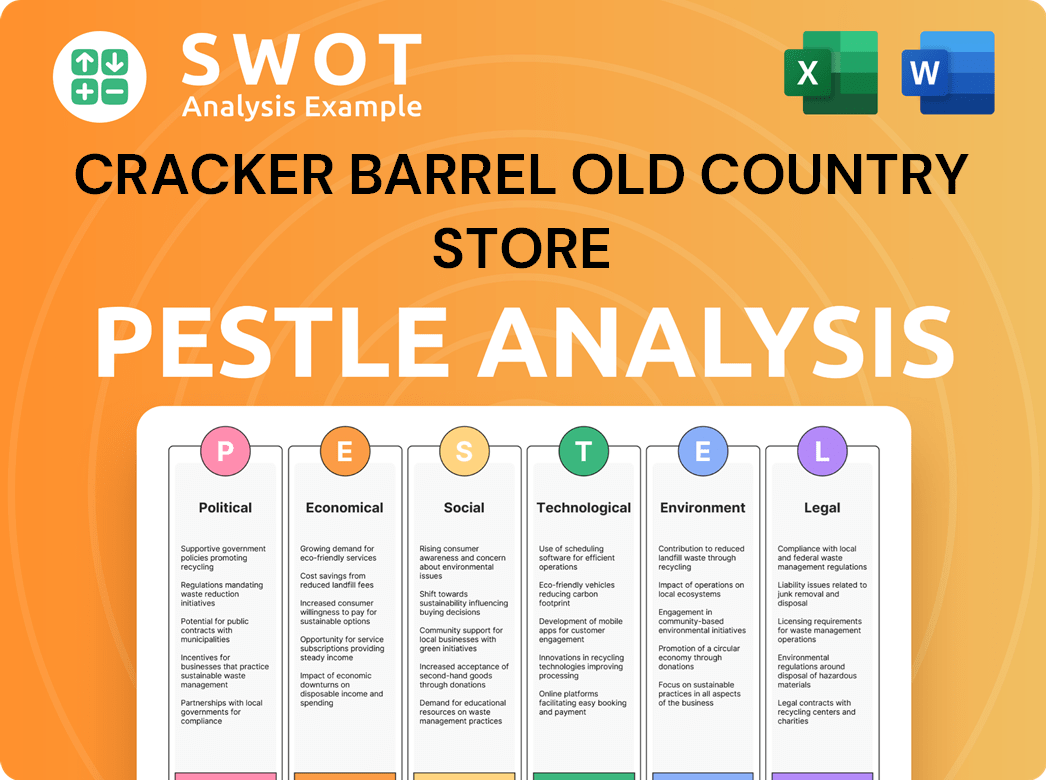
What are the key Milestones in Cracker Barrel Old Country Store history?
The Cracker Barrel Old Country Store's journey, a significant part of Cracker Barrel history, has been marked by strategic milestones that have shaped its identity and market position. From its Cracker Barrel origins to its current status, the company has consistently adapted to market changes while maintaining its core values. Understanding the Cracker Barrel company's evolution provides valuable insights into its resilience and ability to resonate with a broad customer base.
| Year | Milestone |
|---|---|
| 1969 | Dan Evins founded the first Cracker Barrel Old Country Store in Lebanon, Tennessee, with the vision to create a place where travelers could enjoy a home-cooked meal and shop for unique gifts. |
| 1970s | Cracker Barrel expanded its footprint, focusing on locations near interstate highways to attract travelers. |
| 1980s | The company went public, enabling further expansion and growth across the United States. |
| 1990s | Cracker Barrel faced controversies and initiated strategic changes to address public relations challenges. |
| 2000s | The company continued to expand, introducing new menu items and retail offerings to enhance the customer experience. |
| 2020-2021 | Cracker Barrel adapted to the COVID-19 pandemic by enhancing its digital platforms and offering curbside pickup and delivery services. |
Innovation has been a cornerstone of Cracker Barrel restaurants' success, allowing it to maintain its appeal and adapt to changing consumer preferences. The company has consistently refined its approach to meet evolving customer expectations, ensuring relevance in a competitive market.
Cracker Barrel has replicated its 'Old Country Store' experience across numerous locations, ensuring brand consistency. This includes standardized decor, menu, and retail offerings, creating a familiar and nostalgic environment.
The company has innovated its supply chain by sourcing regional products for its stores. This enhances the authentic country store feel and supports local economies.
Cracker Barrel has continuously updated its menu to include new items while retaining its classic homestyle dishes. This ensures that the menu remains appealing to a broad customer base.
Investments in digital platforms, including online ordering and mobile apps, have improved the customer experience. These enhancements provide convenience and accessibility for customers.
The introduction of loyalty programs has helped to build customer relationships and encourage repeat business. These programs offer rewards and incentives to frequent customers.
Cracker Barrel has adapted to changing consumer preferences by offering curbside pickup and delivery services. This provides customers with convenient options for enjoying their meals.
Despite its successes, Cracker Barrel Old Country Store has faced various challenges, which have required strategic responses to maintain its market position. These challenges have tested the company's resilience and ability to adapt to changing conditions.
Market downturns and economic recessions have impacted consumer spending, affecting Cracker Barrel's revenue. These periods require careful financial management and strategic adjustments.
Competition from other casual dining chains and specialty retailers necessitates continuous efforts to maintain its unique appeal. This requires ongoing innovation and differentiation.
Controversies related to corporate policies have led to public relations challenges and a need for strategic repositioning. Addressing these issues requires transparency and proactive communication.
Evolving consumer preferences, including demand for healthier options and convenience, require menu and service adjustments. Adapting to these changes is crucial for long-term success.
Disruptions to the supply chain, such as those experienced during the COVID-19 pandemic, can impact operations and profitability. Effective supply chain management is essential.
Inflation and rising costs, particularly for food and labor, can squeeze profit margins. Managing costs effectively is crucial for maintaining profitability. In fiscal year 2023, Cracker Barrel's cost of goods sold increased to $1.08 billion, reflecting these pressures.
For more insights into the Cracker Barrel's target audience, explore the Target Market of Cracker Barrel Old Country Store.
Cracker Barrel Old Country Store Business Model Canvas
- Complete 9-Block Business Model Canvas
- Effortlessly Communicate Your Business Strategy
- Investor-Ready BMC Format
- 100% Editable and Customizable
- Clear and Structured Layout
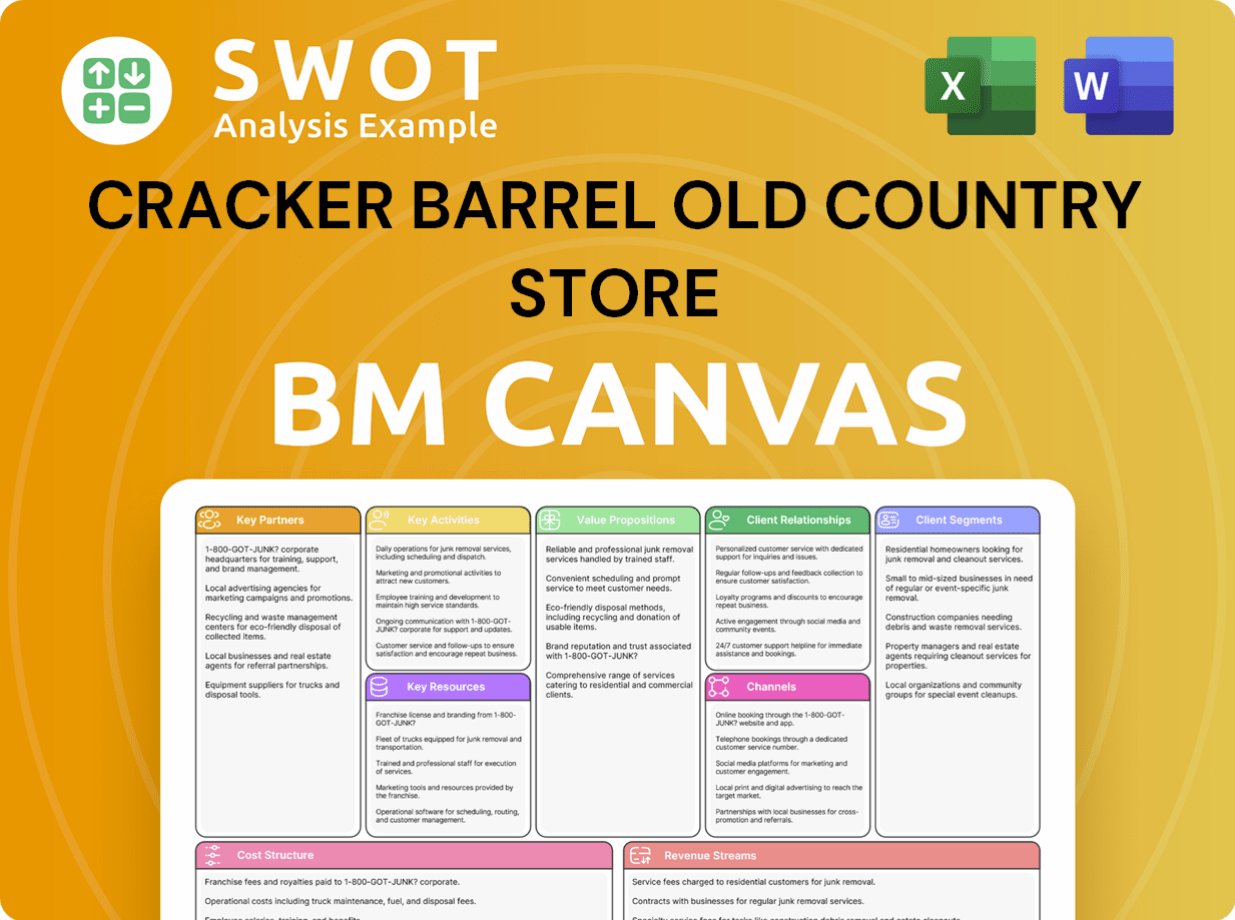
What is the Timeline of Key Events for Cracker Barrel Old Country Store?
The story of the Cracker Barrel Old Country Store began in 1969 when Dan Evins opened the first store in Lebanon, Tennessee, marking the Cracker Barrel origins. The company quickly expanded, reaching ten stores by 1977 and going public in 1981. The Cracker Barrel company continued to grow, opening its 100th location in 1990. In 1992, it was listed on the New York Stock Exchange, and the 2000s saw further expansion with menu and retail refinements. The 2010s brought new menu items and a focus on digital presence. Adapting to the pandemic in 2020, the company implemented curbside pickup and delivery. In 2023, Cracker Barrel restaurants reported approximately $3.33 billion in total revenue.
| Year | Key Event |
|---|---|
| 1969 | Dan Evins founded the first Cracker Barrel Old Country Store in Lebanon, Tennessee. |
| 1977 | The company reached ten store locations. |
| 1981 | Cracker Barrel Old Country Store went public with its initial public offering (IPO). |
| 1990 | The 100th Cracker Barrel location opened. |
| 1992 | Cracker Barrel was listed on the New York Stock Exchange. |
| 2000s | Continued expansion across the U.S., with a focus on refining the menu and retail offerings. |
| 2010s | Introduction of new menu items and enhanced focus on digital presence and online retail. |
| 2020 | Adapts to the global pandemic by implementing curbside pickup and delivery services. |
| 2023 | Cracker Barrel reported approximately $3.33 billion in total revenue. |
| 2024 | Cracker Barrel operates over 660 stores in 45 states. |
In 2025, the company is expected to continue focusing on menu innovation and digital engagement. Operational efficiency will also be a key driver of growth. Cracker Barrel aims to leverage its established brand and loyal customer base.
The company is positioned to capitalize on the increasing demand for convenience and unique dining experiences. It faces a competitive market, but the company's strong brand recognition and customer loyalty provide a solid foundation. The company's long-term strategic initiatives include store refreshes and new dining options.
Looking ahead, Cracker Barrel's future will depend on adapting to modern consumer demands while preserving its heritage. The company's long-term goals include refreshing existing stores and exploring new store formats. Leadership is committed to evolving with the times while staying true to its roots.
Cracker Barrel is focused on enhancing the guest experience and optimizing its menu. Technological advancements will also play a key role in its future. The company is exploring off-premise dining options to meet evolving consumer needs.
Cracker Barrel Old Country Store Porter's Five Forces Analysis
- Covers All 5 Competitive Forces in Detail
- Structured for Consultants, Students, and Founders
- 100% Editable in Microsoft Word & Excel
- Instant Digital Download – Use Immediately
- Compatible with Mac & PC – Fully Unlocked
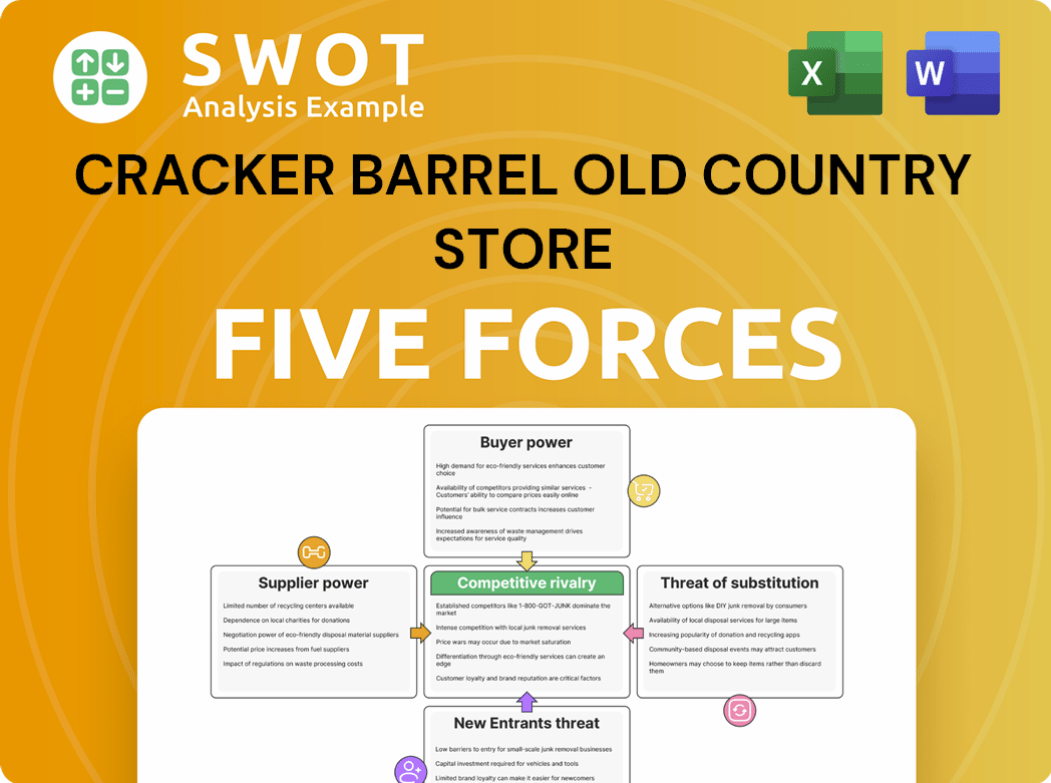
Related Blogs
- What is Competitive Landscape of Cracker Barrel Old Country Store Company?
- What is Growth Strategy and Future Prospects of Cracker Barrel Old Country Store Company?
- How Does Cracker Barrel Old Country Store Company Work?
- What is Sales and Marketing Strategy of Cracker Barrel Old Country Store Company?
- What is Brief History of Cracker Barrel Old Country Store Company?
- Who Owns Cracker Barrel Old Country Store Company?
- What is Customer Demographics and Target Market of Cracker Barrel Old Country Store Company?
Disclaimer
All information, articles, and product details provided on this website are for general informational and educational purposes only. We do not claim any ownership over, nor do we intend to infringe upon, any trademarks, copyrights, logos, brand names, or other intellectual property mentioned or depicted on this site. Such intellectual property remains the property of its respective owners, and any references here are made solely for identification or informational purposes, without implying any affiliation, endorsement, or partnership.
We make no representations or warranties, express or implied, regarding the accuracy, completeness, or suitability of any content or products presented. Nothing on this website should be construed as legal, tax, investment, financial, medical, or other professional advice. In addition, no part of this site—including articles or product references—constitutes a solicitation, recommendation, endorsement, advertisement, or offer to buy or sell any securities, franchises, or other financial instruments, particularly in jurisdictions where such activity would be unlawful.
All content is of a general nature and may not address the specific circumstances of any individual or entity. It is not a substitute for professional advice or services. Any actions you take based on the information provided here are strictly at your own risk. You accept full responsibility for any decisions or outcomes arising from your use of this website and agree to release us from any liability in connection with your use of, or reliance upon, the content or products found herein.